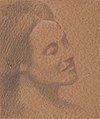
Gibran Khalil Gibran, usually referred to in English as Kahlil Gibran, was a Lebanese-American writer, poet and visual artist, also considered a philosopher although he himself rejected the title. He is best known as the author of The Prophet, which was first published in the United States in 1923 and has since become one of the best-selling books of all time, having been translated into more than 100 languages.

Harold Witter Bynner, also known by the pen name Emanuel Morgan, was an American poet and translator. He was known for his long residence in Santa Fe, New Mexico, and association with other literary figures there.
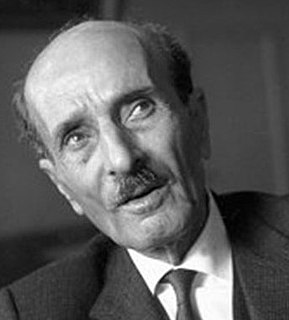
Mikha'il Nu'ayma, better known in English by his pen name Mikhail Naimy, was a Lebanese Greek Orthodox poet, novelist, and philosopher, famous for his spiritual writings, notably The Book of Mirdad. He is widely recognized as one of the most important figures in modern Arabic literature and one of the most important spiritual writers of the 20th century.

Gandalf is an Austrian new-age composer. He plays a wide variety of instruments, including guitar, keyboard, synthesizers and sitars. He includes electronic sounds in his music and is most renowned for forming the fellowship of the ring.
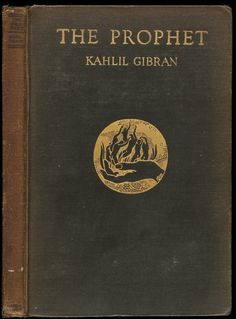
The Prophet is a book of 26 prose poetry fables written in English by the Lebanese-American poet and writer Kahlil Gibran. It was originally published in 1923 by Alfred A. Knopf. It is Gibran's best known work. The Prophet has been translated into over 100 different languages, making it one of the most translated books in history, as well as one of the best selling books of all time. It has never been out of print.

May Elias Ziadeh was a Lebanese-Palestinian poet, essayist, and translator, who has written many different works both in Arabic and in French.
Youssef Saadallah Howayek (1883–1962) was a painter, sculptor and writer from Helta, in modern-day Lebanon.

Paul-Gordon Chandler is the Bishop of the Episcopal Diocese of Wyoming in the USA. An author, art curator, peacemaker, and social entrepreneur, his previous roles have included serving as both a non-profit executive and US Episcopal priest. Paul-Gordon Chandler grew up in West Africa (Senegal) and has lived and worked in leadership roles throughout the world, with an emphasis on the Middle East and Africa, with ecumenical publishing, relief and development agencies, the arts and The Episcopal Church. His acclaimed book on Kahlil Gibran, the best-selling Lebanese born poet-artist and author of The Prophet, is IN SEARCH OF A PROPHET: A Spiritual Journey with Kahlil Gibran.
The Mahjar was a literary movement started by Arabic-speaking writers who had emigrated to America from Ottoman-ruled Lebanon, Syria and Palestine at the turn of the 20th century. Like their predecessors in the Nahda movement, writers of the Mahjar movement were stimulated by their personal encounter with the Western world and participated in the renewal of Arabic literature, hence their proponents being sometimes referred to as writers of the "late Nahda". These writers, in South America as well as the United States, contributed indeed to the development of the Nahda in the early 20th century. Kahlil Gibran is considered to have been the most influential of the "Mahjar poets" or "Mahjari poets".

Francis bin Fathallah bin Nasrallah Marrash, also known as Francis al-Marrash or Francis Marrash al-Halabi, was a Syrian scholar, publicist, writer and poet of the Nahda or the Arab Renaissance, and a physician. Most of his works revolve around science, history and religion, analysed under an epistemological light. He traveled throughout Western Asia and France in his youth, and after some medical training and a year of practice in his native Aleppo, during which he wrote several works, he enrolled in a medical school in Paris; yet, declining health and growing blindness forced him to return to Aleppo, where he produced more literary works until his early death.

Khalil or Khaleel means friend and is a common male first name in the Middle East, the Caucasus, the Balkans, North Africa, West Africa, East Africa, Central Asia and among Muslims in South Asia and as such is also a common surname. It is also used amongst Turkic peoples of Russia and African Americans. The female counterpart of this name is Khalila or Khaleela.

Kahlil G. Gibran, sometimes known as "Kahlil George Gibran", was a Lebanese American painter and sculptor from Boston, Massachusetts. A student of the painter Karl Zerbe at the School of the Museum of Fine Arts, Boston, Gibran first received acclaim as a magic realist painter in the late 1940s when he exhibited with other emerging artists later known as the "Boston Expressionists". Called a "master of materials", as both artist and restorer, Gibran turned to sculpture in the mid-fifties. In 1972, in an effort to separate his identity from his famous relative and namesake, the author of The Prophet, Gibran Kahlil Gibran, who was cousin both to his father Nicholas Gibran and his mother Rose Gibran, the sculptor co-authored with his wife Jean a biography of the poet entitled Kahlil Gibran His Life And World. Gibran is known for multiple skills, including painting; wood, wax, and stone carving; welding; and instrument making.
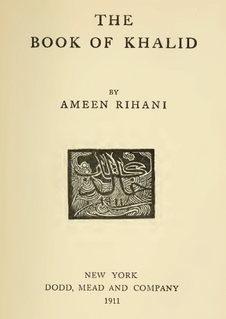
The Book of Khalid (1911) is a novel by Arab-American writer Ameen Rihani. Composed during a sojourn in the mountains of Lebanon, it is considered to be the first novel by an Arab-American writer in English. His contemporary, Khalil Gibran, illustrated the work, and the story is often seen as an influence on Gibran's own well-known book The Prophet.

Alexandre Najjar is a Lebanese and French writer, lawyer, businessman, journalist and literary critic. He was born in Beirut and studied at Panthéon-Assas University and University of Paris 1 Pantheon-Sorbonne. He holds a Doctorate in Business administration and is specialized in banking and finance law. He is the author of more than 30 books translated into more than 12 languages. In addition to poetry and novels, he has written non fiction works like the biography of Khalil Gibran, the author of The Prophet., a book about the 1936 Summer Olympic Games in Nazi Germany and a book about the Arab Spring.
The Baháʼí Faith (بهائی) has a following of at least several hundred people in Lebanon dating back to 1870. The community includes around 400 people, with a centre in Beit Mery, just outside the capital Beirut, and cemeteries in Machgara and Khaldeh. On the other hand, the Association of Religion Data Archives estimated some 3,900 Baháʼís in 2005.
Margaret McQueen Crosland is an English literary biographer and translator. She has also used the pen name Leonard de Saint-Yves.
Suheil Badi Bushrui was a professor, author, poet, critic, translator, and peace maker. He was a prominent scholar in regard to the life and works of the Lebanese-American author and poet Kahlil Gibran.
Al-Funoon was an Arabic-language magazine founded in New York City by Nasib Arida in 1913 and co-edited by Mikhail Naimy, "so that he might display his knowledge of international literature." As worded by Suheil Bushrui, it was "the first attempt at an exclusively literary and artistic magazine by the Arab immigrant community in New York."
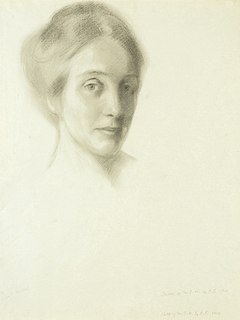
Mary Elizabeth Haskell, later Minis, was an American educator, best known for having been the benefactress of Lebanese-American writer, poet and visual artist Kahlil Gibran.

Abd al-Masih Haddad was a Syrian writer of the Mahjar movement and journalist. His magazine As-Sayeh, started in 1912 and continued until 1957, presented the works of prominent Mahjari literary figures in the United States and became the "spokesman" of the Pen League which he co-founded with Nasib Arida in 1915 or 1916. His collection Hikayat al-Mahjar, which he published in 1921, extended "the scope of the readership of fiction" in modern Arabic literature according to Muhammad Mustafa Badawi.






















